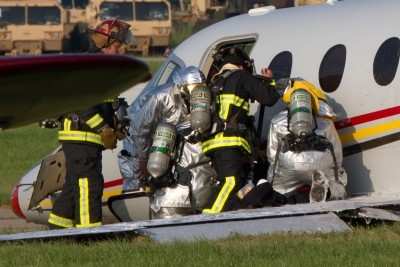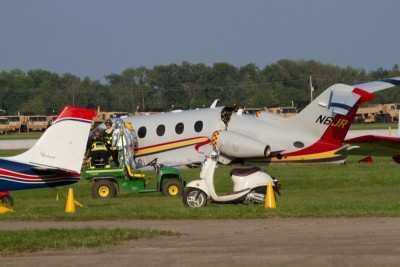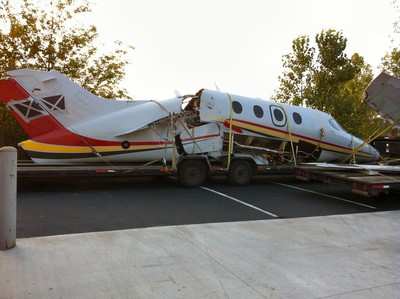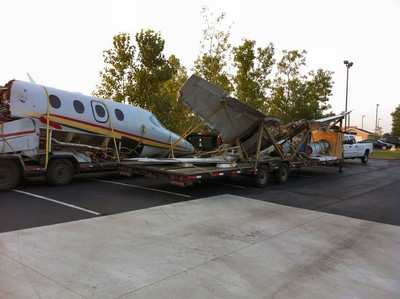Potentially Devastating Crash Yielding Few Details At This
Point
While the NTSB will, necessarily, need a lot more time before
filing a final report, the pictures and other details making
themselves known show one thing, conclusively... that this could
have been a truly tragic accident --and for reasons well beyond the
hazards encountered by those aboard. Pictures and ground track data
indicate that the Premier came perilously close to taking a
course/energy line that could have severely hazarded people on the
ground... and the pictures of nearby photographers running to avoid
the approaching jet provide dramatic testimony to the
possibilities.

One thing is for certain, this aircraft was NOT on a stabilized
approach and while few approaches into Oshkosh fit the normal
definition of "stable," there seems to be little question that this
is an accident that was avoidable had the pilot aborted the
approach and gone around...
NTSB Identification: CEN10FA443
14 CFR Part 91: General Aviation
Accident occurred Tuesday, July 27, 2010 in Oshkosh, WI
Aircraft: Hawker Beechcraft 390, registration: N6JR
Injuries: 2 Serious.

This is preliminary information, subject to change, and may
contain errors. Any errors in this report will be corrected when
the final report has been completed.
On July 27, 2010, approximately 1816 central daylight time (all
times referenced as central daylight time), a Hawker Beechcraft
model 390 (Premier IA) business jet, N6JR, registered to and
operated by Roush Fenway Racing, LLC, was substantially damaged
when it impacted terrain during landing to runway 18R at Wittman
Regional Airport (KOSH), Oshkosh, Wisconsin. Day visual
meteorological conditions prevailed at the time of the accident.
The business flight was being conducted under the provisions of 14
Code of Federal Regulations Part 91. The airline transport
certificated pilot and his passenger were seriously injured. The
cross-country flight had departed Willow Run Airport (KYIP), near
Ypsilanti, Michigan, at 1729 with KOSH as the intended
destination.

The pilot was flying to KOSH to attend the Experimental Aircraft
Association’s Airventure 2010 fly-in convention. Air traffic
control (ATC) data indicated that the accident flight entered the
Oshkosh area under visual flight rules and was cleared to land on
runway 18R (8,002 feet by 150 feet, concrete).
A review of amateur video taken at KOSH showed the accident
airplane in a left base turn to final for runway 18R. The airplane
appeared to overshoot the runway centerline during this turn and
then level its wings momentarily before entering a slight right
bank simultaneously as the nose of the airplane pitched up. The
airplane then turned left toward the runway centerline and began a
descent. During this descent the airplane’s pitch appeared to
increase until the airplane entered a right bank and struck the
grass area west of the runway in a nose down, right wing low
attitude.
The pilot and passenger were assisted out of the aircraft and
transported to the hospital for treatment of their serious, but
non-life-threatening injuries.

An on-scene investigation was immediately initiated after the
accident. The air traffic controllers working the final portion of
the accident flight were interviewed and the recorded ATC voice
transmissions were secured for further review. The final segments
of the accident flight were below available radar coverage, and as
such no radar track data was available for review. The wreckage
debris path and accident site were surveyed before the airplane was
eventually recovered to a secured area where further inspections
were performed the following day. No preimpact malfunctions or
anomalies were noted during the on-scene inspections of the
airframe structure, flight control systems, or two turbo-fan
engines. Several non-volatile memory devices were removed from the
airplane and were retained for future download. A cockpit voice
recorder was recovered and shipped to the NTSB Vehicle Recorder
Division in Washington D.C. for readout. The remaining wreckage was
released back to the aircraft owner/operator on July 29, 2010.
 ANN FAQ: Contributing To Aero-TV
ANN FAQ: Contributing To Aero-TV ANN's Daily Aero-Linx (05.29.24)
ANN's Daily Aero-Linx (05.29.24) ANN's Daily Aero-Term (05.29.24): NORDO (No Radio)
ANN's Daily Aero-Term (05.29.24): NORDO (No Radio) ANN's Daily Aero-Term (05.30.24): Beyond Visual Line Of Sight (BVLOS)
ANN's Daily Aero-Term (05.30.24): Beyond Visual Line Of Sight (BVLOS) ANN's Daily Aero-Linx (05.30.24)
ANN's Daily Aero-Linx (05.30.24)






